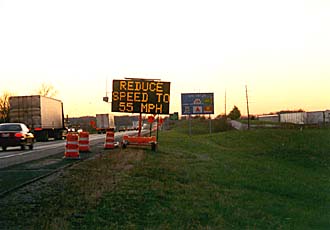U.S. Department of Transportation
Federal Highway Administration
1200 New Jersey Avenue, SE
Washington, DC 20590
202-366-4000
Focus
| Accelerating Infrastructure Innovations |
Date: January 1999
Highway maintenance projects create difficulties for highway workers and motorists alike. Project crews work just steps away from passing traffic, usually separated by only a line of plastic barrels or cones. Motorists must navigate changing traffic patterns, which can cause delays and frustration. They also face an increased risk of rear-end collisions caused by sudden changes in travel speed.
It's not that motorists haven't been warned to slow down as they approach the work zone; rather, many motorists fail to heed the warnings because they find the signs unreliable. They've seen too many "Slow" and "Work Zone Ahead" signs that are still in place after the crews have gone home, or variable message signs whose messages do not reflect current traffic conditions.
Several manufacturers are working to solve this problem by developing systems that use variable message signs to display messages based on real-time measurements of traffic conditions. One such system is Adaptir (Automated Data Acquisition and Processing of Traffic Information in Real-Time), a technology developed by the Scientex Corp. with support from the Federal Highway Administration (FHWA) and the Maryland State Highway Administration (SHA)*.
The Adaptir system measures traffic speeds using Doppler radar, the same technology used by police to detect speeders. Traffic speeds are measured at several points within and upstream of a work zone. The data are then sent to a central control system, which analyzes the data to pinpoint patches of traffic congestion and delay and then selects the appropriate prerecorded message to post on a variable message sign-or series of signs-just upstream of the site.
The messages prepare motorists for actual traffic conditions ahead. For example, if traffic is extremely slow in the work zone, a variable message sign upstream of the work zone might warn of a 10-minute delay ahead; a second sign might then warn drivers to slow to 55 km/h (35 mi/h). If traffic speeds decrease further, indicating worsening congestion, the system would automatically change the signs to indicate an even longer delay and advise of slower speeds ahead. The signs can also be used to suggest alternate routes or tell drivers to tune in to a highway advisory radio station. The system comes packaged with prerecorded messages, but highway agencies can also write their own. To emphasize the timeliness of the messages, each sign can also display the time the message was posted.
Drivers armed with information on traffic ahead are better prepared for changing traffic conditions and thus more likely to have a safe trip. The economic benefits of reducing delays and improving safety at a work zone can outweigh the cost of the Adaptir system by a factor of six or more, according to an economic analysis conducted by Scientex.
An early version of the Adaptir system was tried on two projects in Maryland in 1996. "The system seemed to work pretty well, but we ran into some problems with communications between the speed sensors, central computer, and the variable message signs," says Wayne Styles of the Maryland SHA. Those problems have since been solved, and Maryland SHA is now looking for a suitable site to try the newer version of the system. "We think that it has merit. That's why we were eager to work with it and improve it," Styles says.
The latest Adaptir system is now being evaluated on a maintenance project on Interstate 64 near Frankfort, Kentucky. "We're always looking for new devices that can be used to expedite traffic flow through work zones, both to improve safety and alleviate congestion," says Ken Agent of the Kentucky Transportation Center, who is leading the evaluation project. In the past, he says, variable message signs had to be changed manually. Because it is automated, the Adaptir system, in contrast, will always reflect real-time conditions. The message is always timely, and work crews no longer have to take time away from other tasks to monitor traffic and change the messages.
For more information, contact Ken Agent at the Kentucky Transportation Center at the University of Kentucky, 606-257-4507, x. 253 (fax: 606-257-1815), or Mike Nickolaus at the Scientex Corp., 703-276-3377 (fax: 703-276-0996; email: mnickolaus@scientexcorp.com).
* CHIPS (computerized highway information processing system), which uses the queue length detector developed under the Strategic Highway Research Program (SHRP) to measure traffic speeds, is another such system (see April 1988 Focus).

This Adaptir system sign on Interstate 64 near Frankfort, Kentucky, advises motorists to reduce speed to 88 km/h (55 mi/h).